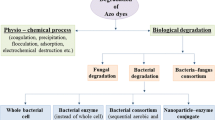Abstract
Pseudomonas strains K22 and KF46 had previously been isolated from chemostat cultures that were adapted to growth on 1-(4′-carboxyphenylazo)-4-naphthol (carboxy-Orange I) and 1-(4′-carboxyphenylazo)-2-naphthol (carboxy-Orange II), respectively. They were tested for their ability to degrade the sulfonated analogs 1-(4′-sulfophenylazo)-4-naphthol (Orange I) and 1-(4′-sulfophenylazo)-4-naphthol (Orange I) and 1-(4′-sulfophenylazo)-2-naphthol (Orange II). The sulfonated dyes served as models for commercially used textile dyes, which are known to be recalcitrant in aerobic waste water treatment plants. Substitution of sulfo for carboxy groups led to disturbance of the degradative pathways. The enzymes initiating degradation, the Orange I azoreductase and the Orange II azoreductase, accepted both, carboxylated and sulfonated dyes. Experiments with specifically 14C-labelled dyes indicated that sulfanilic acid, one of the products of the initial fission of the dyes, was channeled into a dead-end pathway. In the case of Orange I degradation, reactive metabolites of sulfanilic acid, presumably catechols, coupled with aminonaphthol, the other product of the azoreductase reaction. Orange II was degraded by strain KF46 when another suitable carbon source (e.g. 4-hydroxybenzoate) was supplied. Most but not all of the internally generated sulfanilic acid was excreted and intermolecular coupling of aromatic metabolites was not observed. However, the presence of sulfanilic acid and/or its metabolities still interfered with the degradation of the aminonaphthol part of the dye molecule and complete mineralization was not achieved.
Similar content being viewed by others
Abbreviations
- Orange II:
-
1-(4′-sulfophenylazo)-2-naphthol
- carboxy-Organe II:
-
1-(4′-carboxyphenylazo)-2-naphthol
- Orange I:
-
1-(4′-sulfophenylazo)-4-naphthol
- carboxy-Orange I:
-
1-(4′-carboxyphenylazo)-4-naphthol
References
Alexander M, Lustigman BK (1966) Effect of chemical structure on microbial degradation of substituted benzenes. J Agr Food Chem 14:410–413
Anliker R (1979) Ecotoxicology of dyestuffs — a joint effort by industry. J Ecotox Environ Safety 3:59–74
Bachofer R, Lingens F, Schäfer W (1975) Conversion of aniline into pyrocatechol by a Nocardia sp.; incorporation of oxygen-18. FEBS Lett 50:288–290
Brilon C, Beckmann W, Hellwig M, Knackmuss H-J (1981) Enrichment and isolation of naphthalenesulfonic acid utilizing Pseudomonads. Appl Environ Microbiol 42:39–43
Brilon C, Beckmann W, Knackmuss H-J (1981) Catabolism of naphthalene-sulfonic acids by Pseudomonas sp. A3 and Pseudomonas sp. C22. Appl Environ Micobiol 42:44–55
Cain RB (1981) Microbial degradation of surfactants and “builder” components. In: Leisinger T, Cook AM, Hütter R, Nüesch J (eds) Microbial degradation of xenobiotics and recalcitrant compounds. Academic Press Inc, London, pp 325–370
Davies JI, Evans WC (1964) Oxidative metabolism of naphthalene by a soil Pseudomonas: The ring-fission mechanism. Biochem J 91:251–261
Durham NN (1956) Bacterial oxidation of p-aminobenzoic acid by Pseudomonas fluorescens. J Bacteriol 72:333–336
Hamilton ID, Holms WH (1970) Measurement of respiration of microorganisms during batch-culture. Laboratory Practice 19:795–798
Johnston JB, Murray R, Cain RB (1975) Microbial metabolism of arylsulfonates. A reassessment of colorimetric methods for the determination of sulfite and their use in measuring desulfonation of aryl and alkylbenzene sulfonates. Antonie van Leeuwenhoek, J Serol Microbiol 41:493–511
Kulla HG (1981) Aerobic bacterial degradation of azo dyes. In: Leisinger T, Cook AM, Hütter R, Nüesch J (eds) Microbial degradation of xenobiotics and recalcitrant compounds. Academic Press Inc, London, pp 387–399
Leidner H, Gloor R, Wuest D, Wuhrmann K (1980) The influence of the sulphonic group on the biodegradability of n-alkylbenzene sulphonates. Xenobiotica 10:47–56
Mechsner K, Wuhrmann K (1982) Cell permeability as a rate limiting factor in the microbial reduction of sulfonated azo dyes. Europ J Appl Microbiol Biotechnol 15:123–126
Meyer U (1981) Biodegradation of synthetic organic colorants. In: Leisinger T, Cook AM, Hütter R, Nüesch J (eds) Microbial degradation of xenobiotics and recalcitrant compounds. Academic Press Inc, London, pp 371–385
Mulik JD, Sawicki E (eds) (1979) Ion chromatographic analysis of environmental pollutants, vol 2. Ann Arbor Science Publishers Inc, Ann Arbor, Michigan
Pfennig N, Lippert D (1966) Über das Vitamin B12-Bedürfnis phototropher Schwefelbakterien. Arch Mikrobiol 55:245–256
Streule U, von Wattenwyl A (1979) Eine HPLC-Methode zur Trennung sulfonierter and carboxylierter aromatischer Verbindungen. Chromatographia 12:25–28
Weatherburn MW (1967) Phenol-hypochlorite reaction for determination of ammonia. Anal Chem 39:971–974
Wuhrmann K, Mechsner K, Kappeler T (1980) Investigation on ratedetermining factors in the microbial reduction of azo dyes. European J Appl Microbiol Biotechnol 9:325–338
Zimmermann T, Kulla HG, Leisinger T (1982) Properties of purified Orange II azoreductase, the enzyme initiating azo dye degradation by Pseudomonas KF46. Eur J Biochem 129:197–203
Zollinger H (1961) Azo and diazo chemistry: Aliphatic and aromatic compounds. Interscience Publishers, New York London
Author information
Authors and Affiliations
Rights and permissions
About this article
Cite this article
Kulla, H.G., Klausener, F., Meyer, U. et al. Interference of aromatic sulfo groups in the microbial degradation of the azo dyes Orange I and Orange II. Arch. Microbiol. 135, 1–7 (1983). https://doi.org/10.1007/BF00419473
Received:
Accepted:
Issue Date:
DOI: https://doi.org/10.1007/BF00419473




